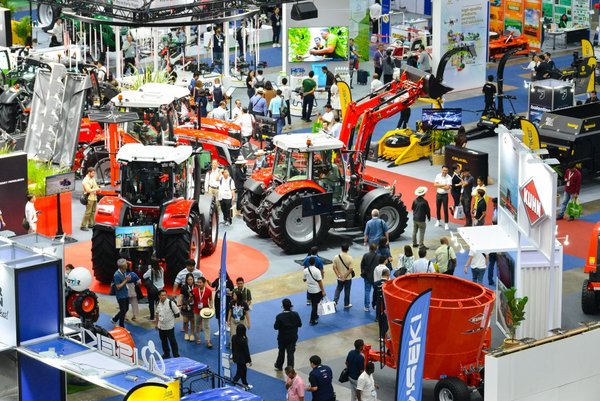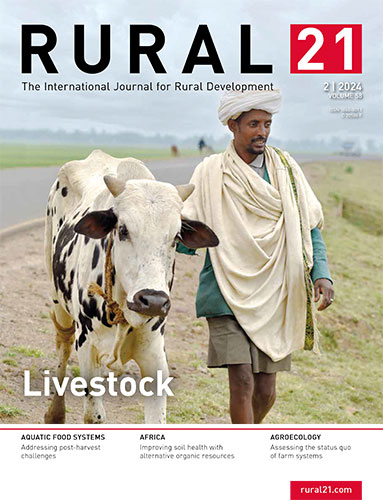 Read this article in French
Read this article in French- Share this article
- Subscribe to our newsletter
Southeast Asia's rice bowl: Challenges and solutions from Agritechnica Asia
Rice, the lifeblood of Southeast Asia, faces numerous challenges. From erratic weather patterns to stagnant yields, producers struggle to keep pace with a growing population and need to adapt on changing environmental conditions. Agritechnica Asia, an agricultural technology exhibition with accompanying conferences in Bangkok, Thailand, held from May 22nd–24th, 2024, aimed to address these issues and offer solutions for a more sustainable future.
The event brought together industry leaders, farmers and researchers from across the region. Over 353 exhibitors showcased cutting-edge technologies and solutions for agriculture and the food sector. More than 12,000 visitors explored the exhibition halls, participated in 45 seminars and presentations and learned from the insights of about 120 speakers.
Climate change disrupts agricultural rhythms with unpredictable floods and droughts. Agritechnica Asia accordingly spotlighted solutions like drought-resistant rice varieties and precision irrigation. These technologies empower farmers to manage water resources efficiently and adapt to changing weather patterns.
Another pressing issue is stagnant rice yields. While overall production has increased, rice yields per hectare remained almost unchanged between 2010 and 2020, except in Cambodia. The event showcased precision agriculture tools that optimise fertiliser use and planting strategies. Improved seed varieties with higher yields and better disease resistance could also have been a focus.
Water scarcity is a growing concern. Rice production is water-intensive, and competition from other sectors is fierce. Agritechnica Asia addressed water-saving solutions like drip irrigation and rainwater harvesting techniques. These technologies can significantly reduce water usage without compromising yield of crops which are less water-demanding than rice.
Pests and diseases are a constant threat to rice crops. New and evolving pathogens attract farmers to spend more on potentially harmful pesticides. Agritechnica Asia presented advancements in biopesticides, precision application methods and disease-resistant rice varieties. These innovations can offer more sustainable and effective pest control.
Burning, a traditional practice for land clearing after harvest, is a major source of air pollution and contributes to soil degradation. Agritechnica Asia showcased alternative solutions like mechanical land clearing equipment and mulching techniques. Discussions on sustainable farming practices that eliminate the need for burning altogether were also a key takeaway.
Apart from these topics, the International Rice Research Institute in a conference linked to the exhibition highlighted approaches dedicated to reducing emissions of greenhouse gases from rice reduction systems and their integration into business models of related carbon markets and finical instruments.
The key elements of Agritechnica Asia 2024
The key takeaways from Agritechnica Asia go beyond specific technologies. Collaboration between farmers, governments and international organisations is crucial to addressing these challenges. The event fostered discussions on knowledge sharing, policy changes and financial support for adopting new technologies. By working together, stakeholders can build a more resilient and sustainable rice production system in Southeast Asia. This focus on sustainability is vital.
Agritechnica Asia promoted practices that not only address immediate challenges but also protect the environment for future generations. This could include discussions on soil health management, reducing reliance on chemical fertilisers and promoting biodiversity.
In conclusion, Agritechnica Asia offered a glimpse of hope for Southeast Asia's rice producers. By adopting the technologies and practices showcased at the event, farmers can increase yields, adapt to climate change and protect the environment. Collaboration and a focus on sustainability are key to ensuring the future of this vital crop.
Rice will be one of the key topics at the upcoming Agritechnica Asia in Vietnam, from the 12th–14th March 2025, highlighting low-emission rice production in Vietnam.
Author: Prof Dr Nils Borchard, Head of Research and Innovation, German Agricultural Society (DLG), Frankfurt/Main, Germany, contact: n.borchard@dlg.org
For more information, visit the Agritechica Asia Website





Add a comment
Be the First to Comment